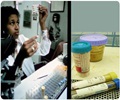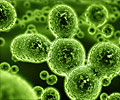A new study published in the online edition of mBio reveals that people who have been infected with bacterium Clostridium difficile benefit through fecal microbiota transplantation.

"The bottom line is fecal transplants work, and not by just supplying a missing bug but a missing function being carried out by multiple organisms in the transplanted feces," Young says. "By restoring this function, C. difficile isn't allowed to grow unchecked, and the whole ecosystem is able to recover."
Young and colleagues used DNA sequencing to study the composition and structure of fecal microbiota (bacteria) in stool samples from 14 patients before and two to four weeks after fecal transplant. In 10 of the patients, researchers also compared stool samples before and after transplant to samples from their donors. All transplant patients, treated at the Essentia Health Duluth Clinic in Minnesota, had a history of at least two recurrent C. difficile infections following an initial infection and failed antibiotic therapy.
Studying families of bacteria in the samples, investigators found marked differences among donor, pre-transplant and post-transplant samples. However, those from the donors and post-transplant patients were most similar to each other, indicating that the transplants at least partially returned a diverse community of healthy gut bacteria to the recipients. While not as robust as their donors, the bacterial communities in patients after transplant showed a reduced amount of Proteobacteria, which include a variety of infectious agents, and an increased amount of Firmicutes and Bacteroidetes bacteria typically found in healthy individuals, compared to their pre-transplant status.
Then, using a predictive software tool, researchers analyzed the relationship between the community structure of the micoorganisms and their function, presumably involved in maintaining resistance against CDI.
They identified 75 metabolic/functional pathways prevalent in the samples. The samples taken from patients before transplant had decreased levels of several modules related to basic metabolism and production of chemicals like amino acids and carbohydrates, but were enriched in pathways associated with stress response, compared to donor samples or post-transplant samples.
Advertisement
Further identification of the specific microorganisms and functions that promote resistance of bacterial colonization, or growth, may aid in the development of improved CDI treatments, Young says: "If we can understand the functions that are missing, we can identify supplemental bacteria or chemicals that could be given therapeutically to help restore proper gut function."
Advertisement













